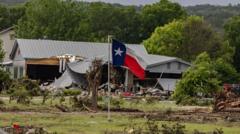Recent flooding in Texas illustrates the alarming impact of climate change, where increased humidity and warmer air create conditions for severe storms, overwhelming outdated infrastructure.
Unprecedented Rainfall in Texas Highlights Growing Climate Threats

Unprecedented Rainfall in Texas Highlights Growing Climate Threats
As global temperatures rise, extreme rainfall events are becoming more intense, leading to catastrophic flooding in areas like Central Texas.
As the planet continues to warm due to human activities, areas like Texas are no strangers to extreme weather, yet the intensity and frequency of severe downpours are on the rise. This trend is evidenced by the recent catastrophic flooding in the Hill Country, a region notorious for its flash floods. The root cause lies in the altered atmospheric conditions, where warmer air, capable of holding more moisture, collides with cooler air masses, resulting in violent storms.
Data shows that the flooding in Texas, characterized by a striking increase in rainfall intensity, exemplifies the effects of climate change on weather patterns. The atmosphere is now rendering storms that might occur with less than a tenth of a percent likelihood in any given year, highlighting the alarming shift in weather extremes. The rapid rise of the Guadalupe River on a recent Friday, from a mere three feet to a staggering 34 feet in just 90 minutes, underscores this stark reality.
The geographical features of Texas, such as its hilly terrain and the convergence of humid air from the Gulf of Mexico and the tropical Pacific, create a perfect storm for extreme rainfall events. Unfortunately, this new normal poses significant challenges for states like Texas, which struggle with both chronic underinvestment in infrastructure and inadequate early warning systems. As these extreme weather events are likely to become more common, it is crucial for communities to adapt to the evolving risks posed by climate change. The need for updated infrastructure and improved response strategies has never been clearer, as the repercussions of inaction could be dire for both people and the environment.
Data shows that the flooding in Texas, characterized by a striking increase in rainfall intensity, exemplifies the effects of climate change on weather patterns. The atmosphere is now rendering storms that might occur with less than a tenth of a percent likelihood in any given year, highlighting the alarming shift in weather extremes. The rapid rise of the Guadalupe River on a recent Friday, from a mere three feet to a staggering 34 feet in just 90 minutes, underscores this stark reality.
The geographical features of Texas, such as its hilly terrain and the convergence of humid air from the Gulf of Mexico and the tropical Pacific, create a perfect storm for extreme rainfall events. Unfortunately, this new normal poses significant challenges for states like Texas, which struggle with both chronic underinvestment in infrastructure and inadequate early warning systems. As these extreme weather events are likely to become more common, it is crucial for communities to adapt to the evolving risks posed by climate change. The need for updated infrastructure and improved response strategies has never been clearer, as the repercussions of inaction could be dire for both people and the environment.




















